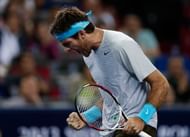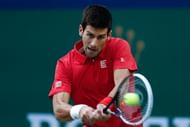Novak Djokovic made it two title wins in two weeks when he successfully defended his Shanghai Masters crown against an in-form Juan Martin Del Potro.
Del Potro himself has had a fine run on the Asian leg of the tour after winning in Japan and finishing runner-up yesterday at Shanghai. The duo were involved in a superb game of tennis that had many moments of technical brilliance from both players.
Djokovic in the end used his big-match experience to pull through in the tie-breaker and make it a rare back-to-back sequence – he successfully defended his crowns at both the China Open in Beijing last week and Shanghai yesterday – making China a very happy hunting ground for the Serb.
Del Potro had dismantled new world number 1 Rafael Nadal in the semi-final and was coming into the final high on confidence. Yet the Serb came up with a tactically astute game plan to neutralize some of the Argentine’s strengths which in the end enabled him to claim victory.
Here’s a statistical look at yesterday’s match as well as the major differences in Del Potro’s matches against Nadal on Saturday and against Djokovic yesterday that proved crucial in deciding the outcome of the respective games.
Serve and return
Unlike in his semi-final match against Nadal, Del Potro made a rather slow start in the final. And Djokovic took full advantage of this by not allowing him to settle on serve.
Djokovic is an excellent returner of serve, one of the best on tour alongside Andy Murray. Del Potro had a first serve percentage of 56% in the first set. Even in the points where he got his first serve in, the Argentine only managed to win 57% of the points and his big serve did not give him the advantage that he had hoped to get.
Much of it was down to the quality of Djokovic’s returns though Del Potro was also guilty of being a bit predictable. He sent in a majority of his serves down the line, both on the ad court as well as the deuce court, which provided easy pickings for Djokovic who had managed to get a good read on them.
Unlike Nadal who stands a little deeper in the court while receiving, Djokovic was stepping into the court and taking the ball early in a bid to pressurize Del Potro in the rallies. And the ploy worked, as it didn’t allow the Argentine to get into his hitting rhythm.
He got butchered on his second delivery as well as he won just 27% of the points when he was asked to deliver a second serve, with the world number 2 pouncing all over it.
In fact, in the whole of the opening set, Djokovic failed to get Del Potro’s serve back in the court on only two occasions out of the 25 points which his opponent served. So there were no easy points on serve for Del Potro.
He faced five break points in the set and though he managed to save three of them, the relentless pressure in almost every service game of his ensured that he was broken twice.
Djokovic, in comparison, served supremely well, getting in 78% of his first serves with plenty of variety to boot, preventing Del Potro from getting his big swings in and asserting his authority on the points. He served so well that he lost just six points on serve the whole set.
Del Potro didn’t for one moment face such pressure in the semis as Nadal stood deeper in the court, as he normally does while receiving, which allowed Del Potro to get the big serve followed by the first strike in to take control of the point.
He even won 9 out of 13 total second serve points in the two sets against Nadal, which goes to show how untroubled he was with the world number 1’s returns. And while holding his own fort, he was giving Nadal a torrid time whenever the latter missed his primary delivery.
In the second set of the final, the tables were turned. The loss of the first set in such comfortable fashion sort of freed up Del Potro as he looked more relaxed in the second and that translated into his game as well.
Djokovic’s first serve percentage dropped to 58% in the second, allowing Del Potro the opportunity to sneak in to grab the crucial break. That, and a crazy sequence of events that saw Djokovic slip-shodding all over the court on his groundstrokes.
The Serb also won just half of the points on his second serve. Del Potro too struggled on his second delivery (44% points won), but had only 9 second serves to 23 first serves, on which he lost just four points.
Ironically, Del Potro faced more break points (3 as compared to 1 by Djokovic), but he saved all of them with some timely big serves and solid shot-making. He also varied his serve by opting for more serves out wide, especially on the deuce court, that kept Djokovic guessing.
The third set saw both players serve really well. Djokovic bumped up his first serve percentage to 66%, winning 88% of those points, while Del Potro sent down an impressive 81% first serves in, winning 63%.
The numbers here are a little misleading, though; while Del Potro served a higher number of first serves, the distribution was less. Conversely Djokovic, despite serving a lower percentage, got more variety, keeping Del Potro stretched, as he lost just three points on his first delivery and only eight points overall. He held his serve in quick time and managed to exert all the pressure on Del Potro who was at a disadvantage serving behind in the decider.
The Argentine had also started to fade a bit physically and he managed to win just 8 of 38 points while returning the Djokovic serve. The Serb had twice that number.
Depth of shot
In the semi-final against Nadal, Del Potro managed to bully the Spaniard into submission. The weight of the shots flowing from Del Potro’s racquet, specially the forehand, managed to inflict some body blows to Nadal.
Nadal’s serve is not at the same level as Djokovic’s, and this was an area that Del Potro exploited to the fullest. Despite serving a healthy 71% first serve in the first set and 70% in the second, Nadal hardly managed to trouble Del Potro, who managed to get the first big strike in the rally before his opponent could more often than not.
It was not just the pace of the shot, but the depth in particular that buried Nadal in the semis. The Spaniard simply could not live with Del Potro from the back of the court as he punished him for dropping the ball short.
Each of Del Potro’s shots was so close to the baseline that it never allowed Nadal to go on the attack and all he could do was put the ball back in the court. That’s how he dominated the rallies and ran Nadal ragged, making him run from corner to corner.
And when he wasn’t hitting winners, there was so much oomph behind his shots that Nadal was forced into errors. He established prime position in the centre of the court and let rip, as Nadal was left to chase those huge forehands and backhands.
Djokovic’s supreme returning skills, already highlighted earlier, did not allow Del Potro to set up for the big shot early in the point. Instead, Djokovic was the one who kept a vice-like grip on Del Potro, not allowing the Argentine a free swing of those long arms.
In the match against Nadal, Del Potro hit 33% of his shots from inside the baseline; against Djokovic that number was just 19% in the first set. As a result, the Serb won the set at a canter by pinning Del Potro to the back of the court. He also won 10 of the 13 rallies that stretched for more than 10 shots.
Djokovic’s serve in turn prevented his opponent from laying down the hammer, until the second set, where a drop off in his serving levels saw Del Potro play more aggressively and start ripping those winners and booming forehands.
Backhand down the line
Two things that Del Potro has vastly improved over the years are his backhand and his movement on the court. The Argentine is a big unit, but manages to cover the court pretty effectively these days.
So the challenge that lay in front of both Nadal and then Djokovic was to unseat him from his position of power from the middle of the back court.
In the game against Nadal, a majority of rallies in their initial stages played out between Nadal’s forehand cross-court to Del Potro’s backhand. The Argentine used his height and reach to good effect to combat the heavy top-spin that Nadal imparts on his shots.
Coming over the backhand beautifully, Del Potro used it as an effective rallying tool, before unleashing those forehand bombs which Nadal could do nothing about. And as a player who likes to run around his backhand, much like Roger Federer, Del Potro tends to veer towards the left, leaving room on the side of his forehand wing.
That is why one sees him attempt so many of those running forehands which he pulls off remarkably, as he needs to cover that side a bit more when his opponents attack it. Nadal found it tough to exploit that wing as he would have had to play a lot of forehands down the line instead of his favoured cross-court.
And when he tried to attack with his backhand, Del Potro found him out by going up the line as well as inside out to Nadal’s forehand, which left Nadal retrieving from side-to-side with some squash-like shots.
When it comes to Djokovic though, the backhand down the line is one of the most beautiful shots that one will see from his racquet. It’s one of his favourite shots and when he plays it well, the timing and efficiency on it make sure that it causes a lot of damage. Every time he plays Federer, the Swiss regularly gets burnt on that forehand wing due to that shot.
He used it to good effect against Del Potro as well to keep him from venturing more to his left in an attempt to get around the backhand. He targeted the forehand of Del Potro, the stronger wing, in an attempt to break it down, and it paid off in the first set as Del Potro struggled to find his radar.
It was only when he got the serve going in the second set that he roared back and one got to see some of the same patterns of play like those in the semi-final against Nadal.
And that’s how Novak Djokovic bested Juan Martin Del Potro, despite being run close yet again by the Argentine.
Every time these two clash on the court, they end up playing a really high-quality match filled with plenty of shots that stick in the memory for a long time to come. Each of their clashes this year has gone the distance and it is a match-up that always delivers on quality and entertainment.
Talking tactics will be back soon with a take on the next big match on the ATP tour.
What is the foot injury that has troubled Rafael Nadal over the years? Check here

